This post is also available in: Español (Spanish) Français (French)
How to Find Twitter Influencers to Grow Your Brand
Twitter influencers can boost your reach, grow your community, and help you reach key X marketing goals. To get these results, you have to find Twitter influencers who are a good fit for your brand.
The Twitter app is a good place to start searching for brand partners. But with an influencer search engine, you get much more powerful tools to find and filter creators.
In this post, you’ll learn:
- Macro influencers vs. micro influencers
- How to find influencers on Twitter for free
- Best platforms to find influencers on Twitter
- Tweet Binder’s influence detection algorytm
Get free stats on any X influencer (up to 200 tweets from the last 7 days). Type “from:@handle” in the search box below.
What is a Twitter influencer?
A Twitter influencer is a person known for having niche expertise. These thought leaders use social media to:
- Create content
- Build audiences
- Lead conversations about specific topics
As a result, these creators can influence how their followers think and act. Many influencers even have the power to guide the:
- Items and services their followers purchase
- Brands they prefer
- Media they consume
Popular actors, musicians, athletes, and media personalities can be influencers. But not all top Twitter influencers are celebrities. Below, we’ll cover different types of influencers.
Get free stats on any celebrity on X (up to 200 tweets from the last 7 days). Type “from:@handle” in the search box below.
Why partner with Twitter influencers?
Working with creators gives you the power to reach Twitter influencer marketing goals like:
- Reach new audiences. Influencers can introduce your brand to audiences you couldn’t reach without ads. The right influencers get your brand in front of people who fit your customer profile.
- Build credibility. Almost 70% of consumers trust influencers, friends, and family more than branded content. That means reaching audiences through influencers can help build trust.
- Create high-performing content. Over a third of marketers report influencer content outperforms branded content. Many brands repost influencer content directly or use it in Twitter ads.
- Increase sales. Working with Twitter content creators can impact revenue. Over 75% of Twitter users say they purchased after seeing an item or service on the platform.
The search bar below will help you to get real impressions of any X user.
Macro influencers vs. micro influencers: Which one to choose?
Accounts with a lot of followers usually have more reach and higher engagement. But influencers with the most followers aren’t always the best partners for your brand.
Yet the most influential Twitter accounts don’t always have the biggest audiences. Here are four types of influencers to consider:
- Celebrity influencers: Have 1 million or more followers. They’re usually famous media, music, or sports personalities. While they have a lot of followers, their engagement rates can be lower.
- Macro influencers: Have between 100,000 and 1 million followers. They’re the sweet spot for many brands. They can give brands a ton of exposure and create conversions like sales.
- Micro influencers: Have between 10,000 and 100,000 followers. They usually have more niche audiences and higher engagement rates. Their pricing tends to be lower too.
- Nano influencers: Have between 1,000 and 10,000 followers. They often have the highest engagement rates. They may also have closer relationships with followers. Yet their total reach is lower.
To find top Twitter accounts for your brand, start by looking at account size. Then create a custom influencer score using factors like:
- Follower / following ratio: Do they have at least a 3:1 ratio?
- Engagement rate: How many likes, reposts, or replies do their tweets get?
- Areas of expertise: What do they discuss?
- Audience: Where are their followers from?
- Pricing: How much do you have to spend to work with influencers?
Related reading – The ultimate guide to Twitter analytics.
How to find influencers on Twitter for free
So how do you connect with top creators? Here’s how to find Twitter influencers in your industry.
Do a hashtag search & analytics
What are the most popular hashtags in your industry? Make a list, and then do a hashtag search and analytics. This is a good way to find popular accounts discussing the topics that matter to your brand and audience.
Enter any combination of keywords or hashtags in the Tweet Binder search bar below. Use the advanced search operators to narrow the results.
For example, say you want to find tweeters that mention #OpenAI or #GPT4 and attach media to the tweet.
You could search for:
#OpenAI #GPT4 has:media
You can quickly find top influencers via Tweet Binder’s contributor rankings. This hashtag report shows top 10 lists of the most popular, most prolific, and most active users tweeting about the topic.
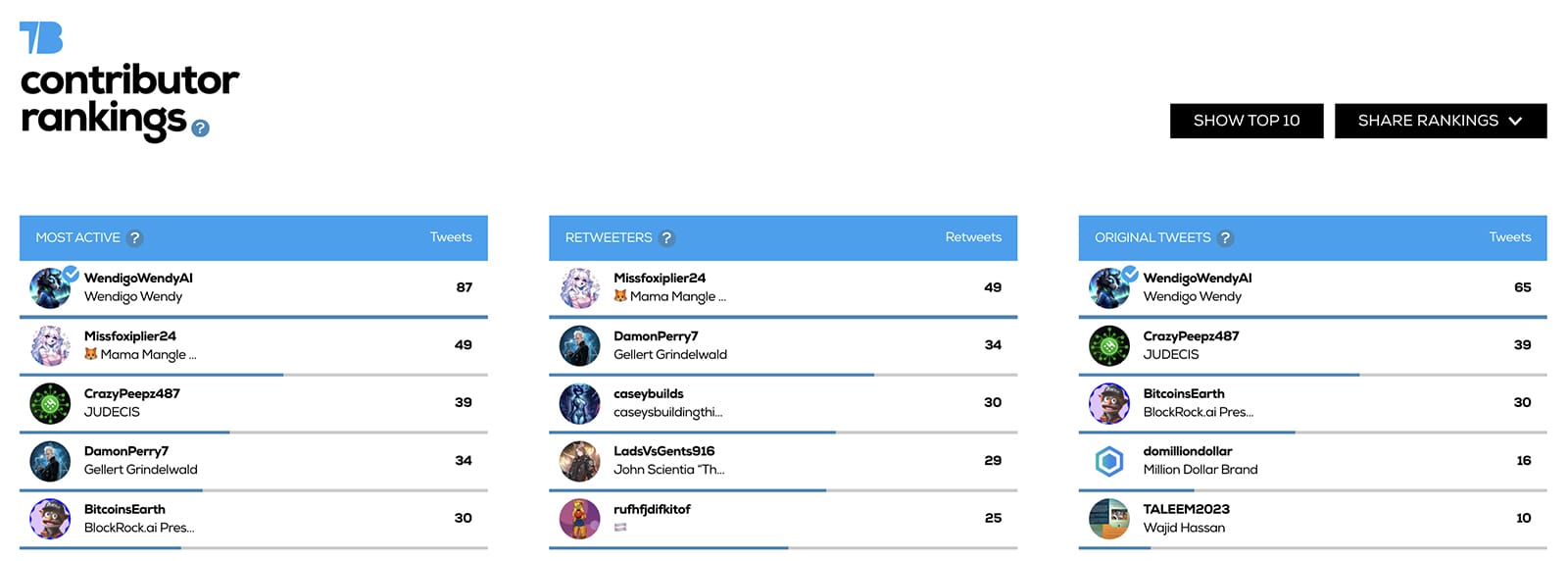
It also reveals the topic’s most viral tweeters. This report is particularly helpful for making a list of influencers who can create viral content.
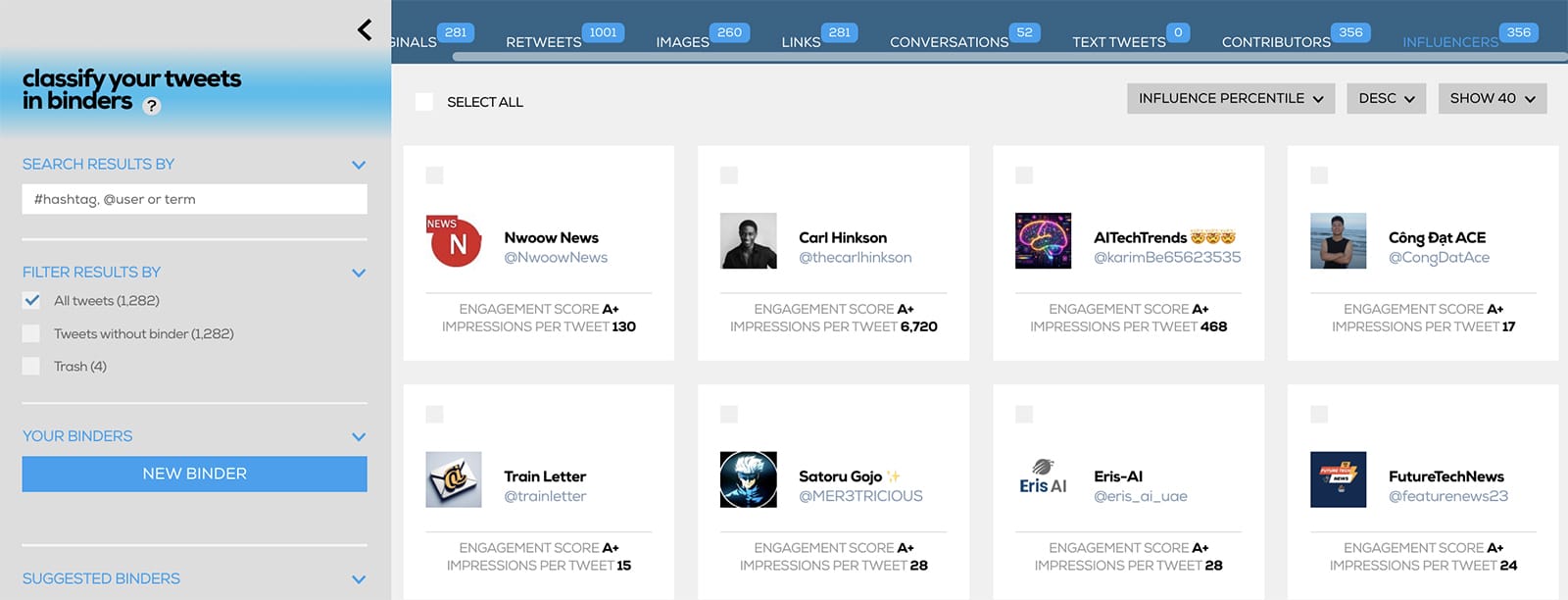
From the Influencers dashboard, you can review users by their engagement score. You can also organize influencers in tweet binders so you can begin mapping out campaigns.
For more in-depth analysis, download the list of contributors as the Excel report. This download option is available with Tweet Binder’s paid plans.
Search your Twitter followers
Start by looking through your own Twitter followers. Why?
If creators follow your account, they already know your brand. That means you can connect and partner with them more easily.
Don’t waste time scrolling through your list of followers in the Twitter app. The app doesn’t display the number of followers, so you have to tap to view each account one at a time.
Instead, use Audiense Connect to do an advanced search of your followers.
Open your community wall and select My Followers as the view. Then use the Search bar to enter a query.
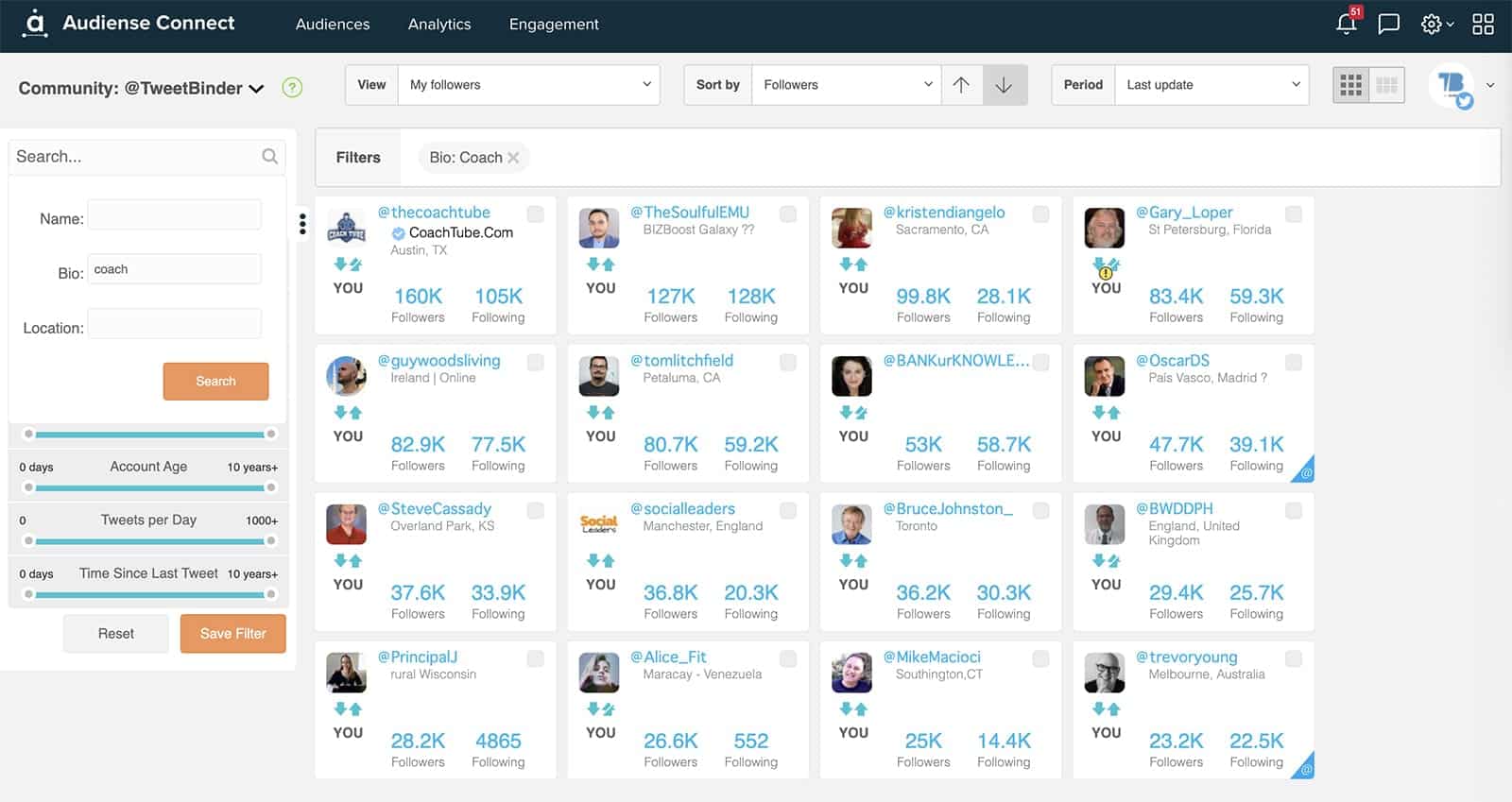
For example, say you want to connect with coaches. Enter “coach” in the Bio field to search for influencers with the keyword in their Twitter bios.
To narrow your search results, you can enter a location.
You can also use advanced syntax to expand your search. For example, you could search for “coach OR creator.”
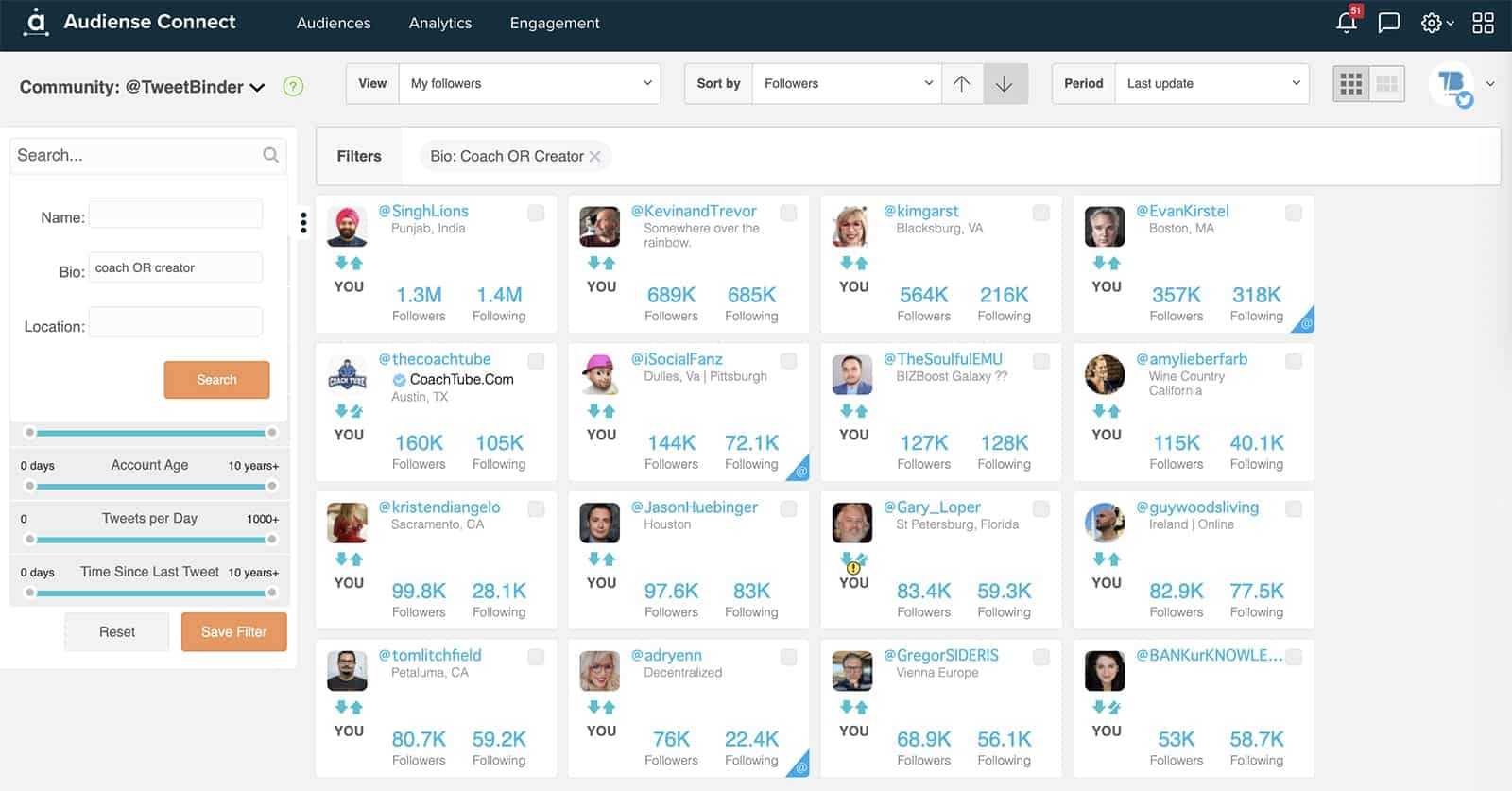
Use Audiense Connect filters to narrow your results further. To define your ideal social media influencer, think about the factors that matter to your brand.
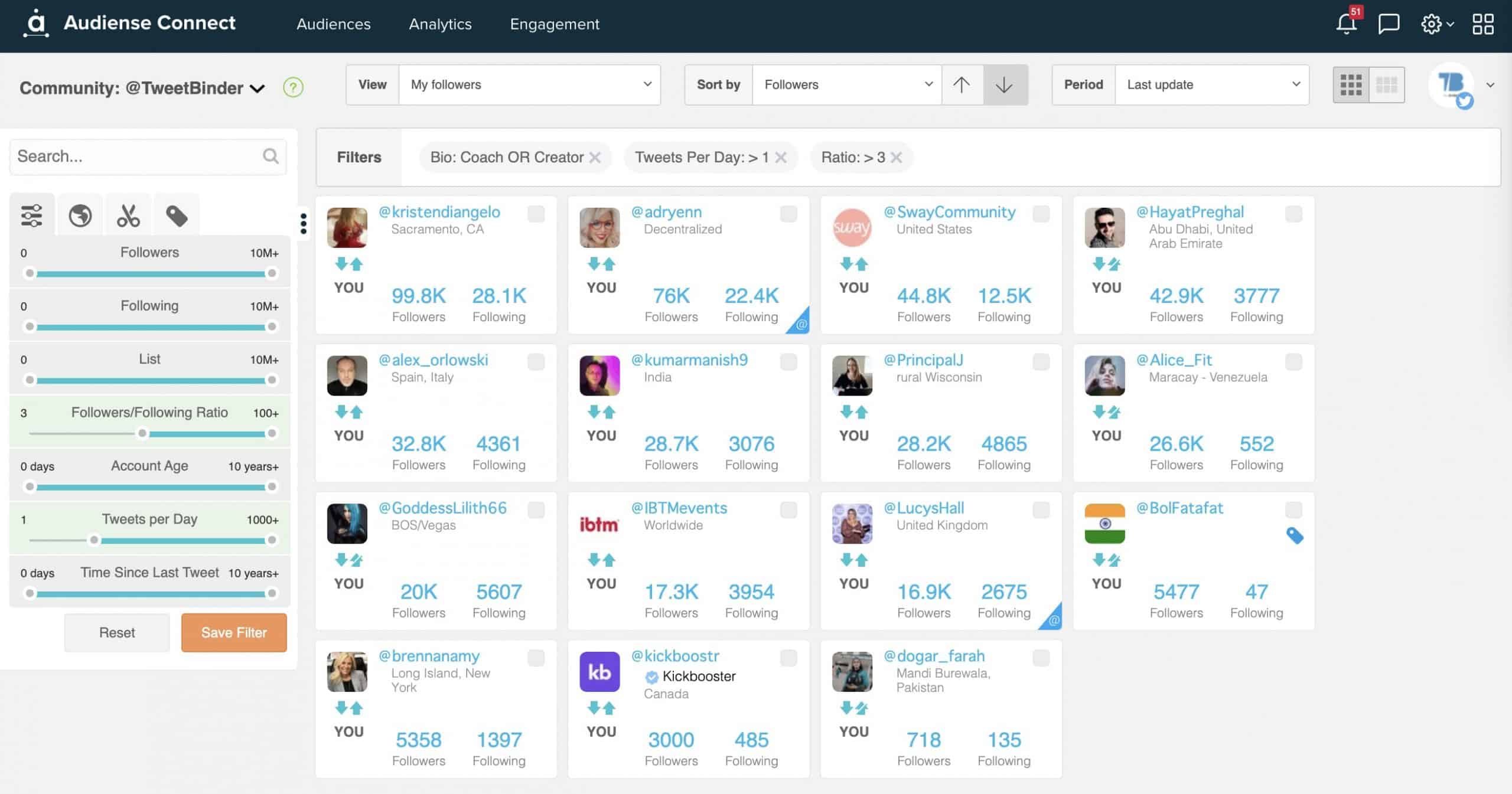
For example, you can filter out anyone with less than a 3:1 follower-to-following ratio. You can also filter out anyone who tweets less than once a day on average.
Related reading – How to audit your Twitter followers.
Search Twitter influencers in your industry
Look beyond your current followers to find the right partners for your brand. With Audiense Connect, you can do a Twitter search of all Twitter users, even if they don’t follow your brand yet.
From your community wall, change the view to All Twitter. Then use the search bar to enter keywords. For example, say you want to find people working in social media marketing.
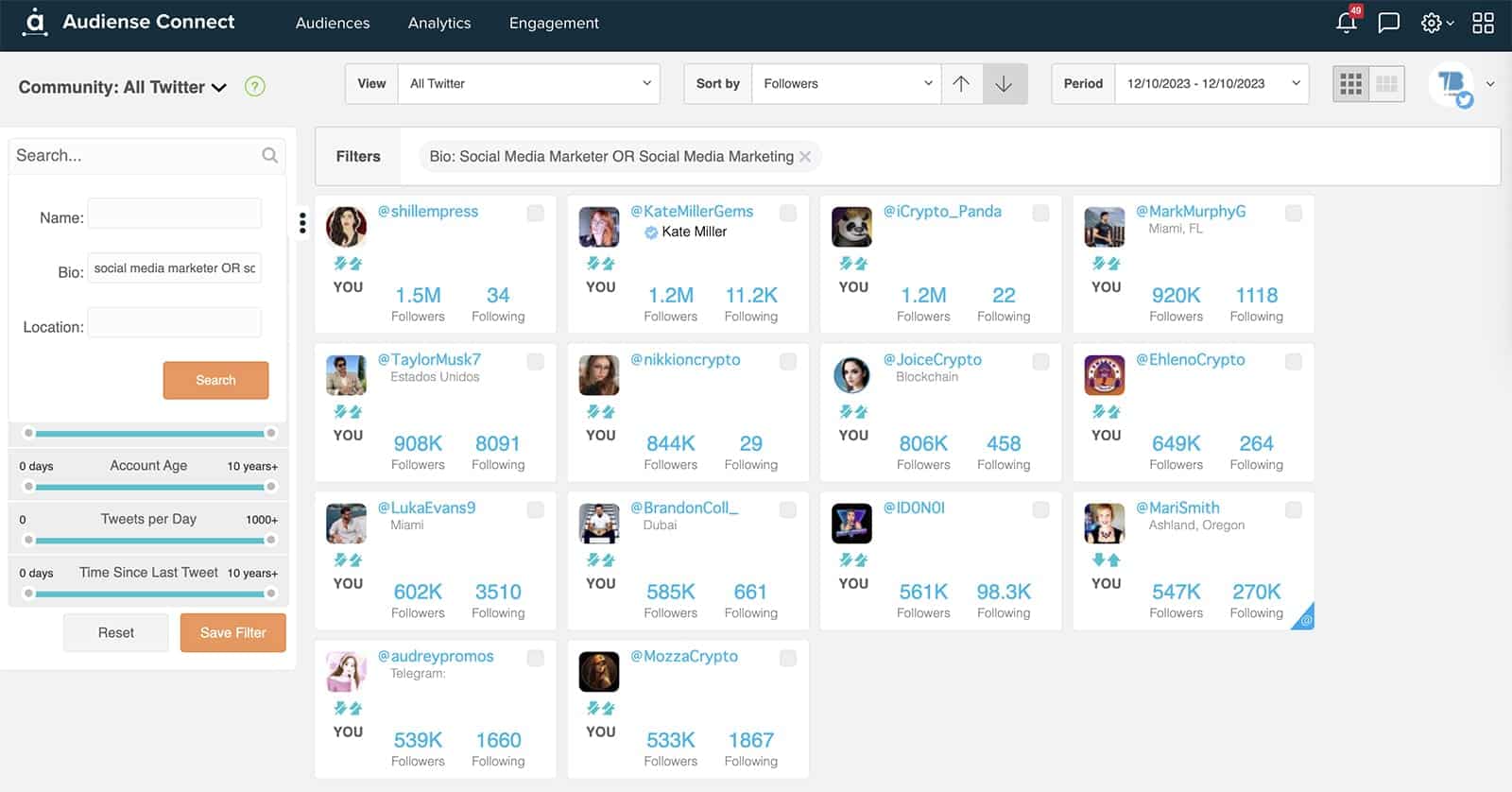
Then use the filters to help you find the most influential people on Twitter in your industry. For example, say you want to find:
- micro influencers with a 3:1 follower ratio;
- who posts an average of 5 tweets daily.
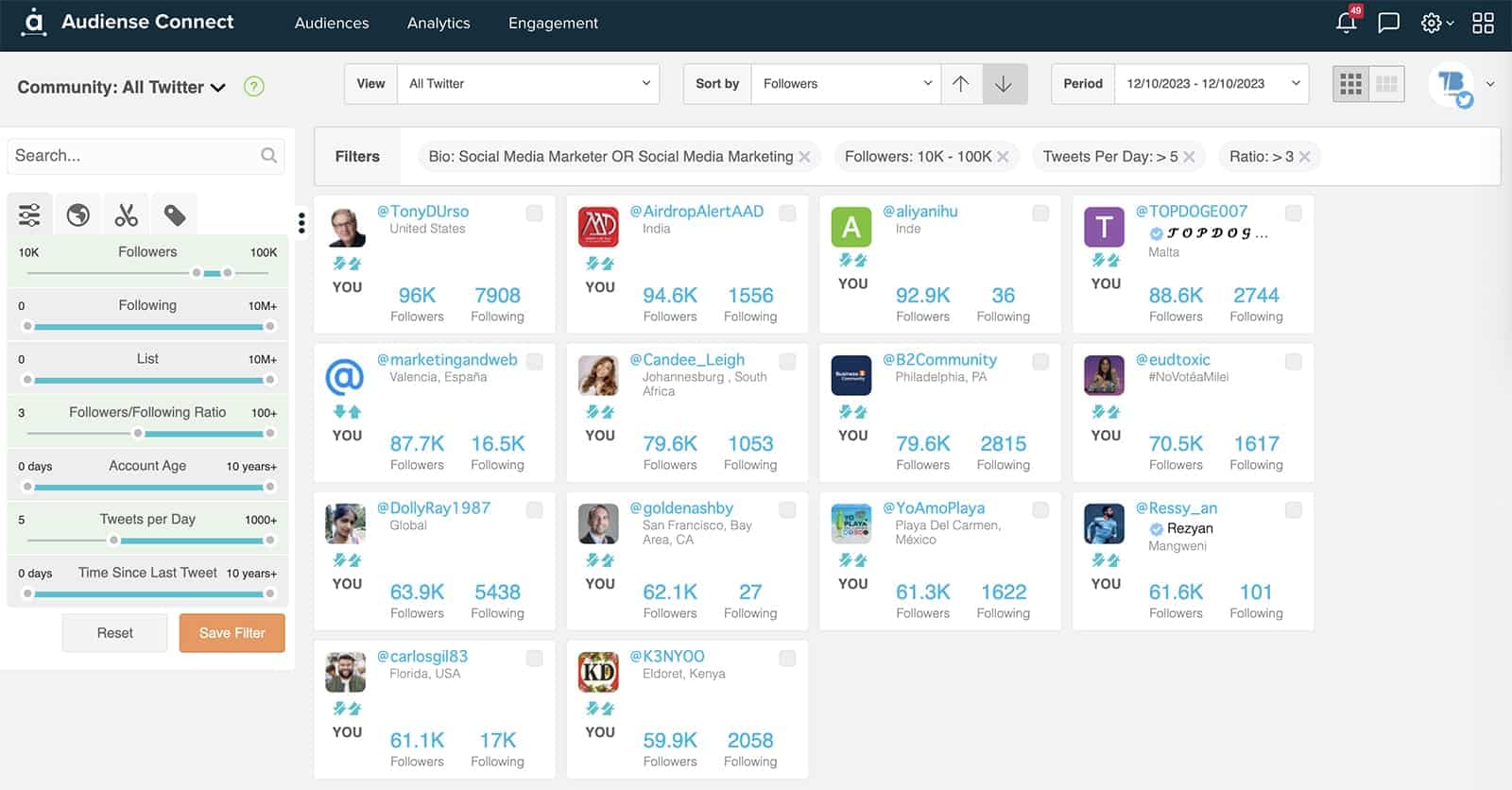
Need a way to find influencers who speak your language or live in your country? Use Audiense Connect’s demographic settings to filter by country and language.
Signup and use Audiense Connect for free.
Related reading – how to find anyone on X.
Leverage Twitter lists to find influencers
Once you find potential partners for your brand, you can use them to find more influencers in your niche. How?
Use Twitter lists for influencer discovery.
Open any influencer’s Twitter profile and click the three dots. From the menu, select View Lists. Then click to view Lists They’re On.
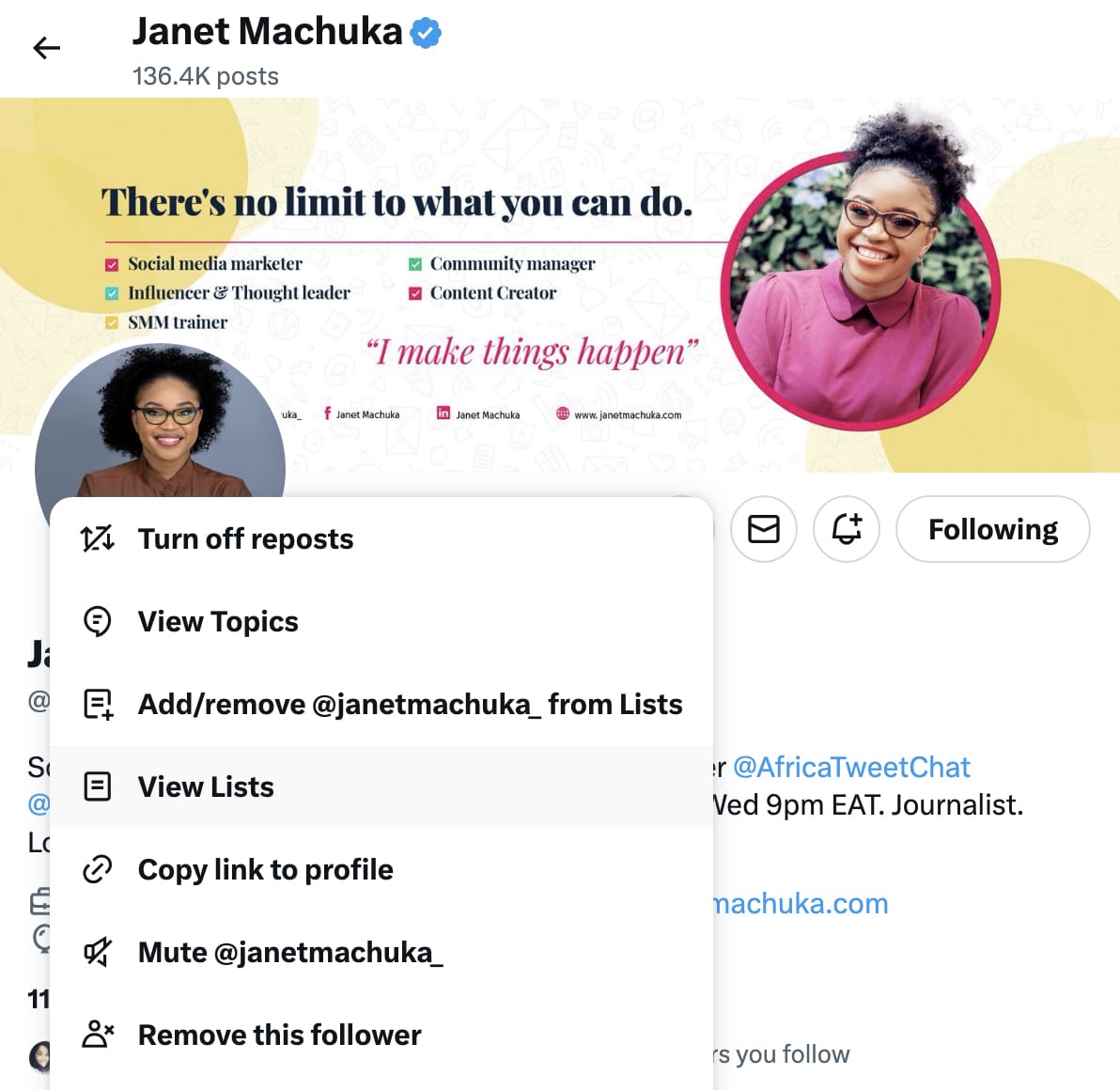
Here, you can view all public lists that feature the influencer. You can use these lists to build out your own influencer database.
To analyze accounts of any public Twitter list, copy the URL. Then import the list into Audiense Connect.
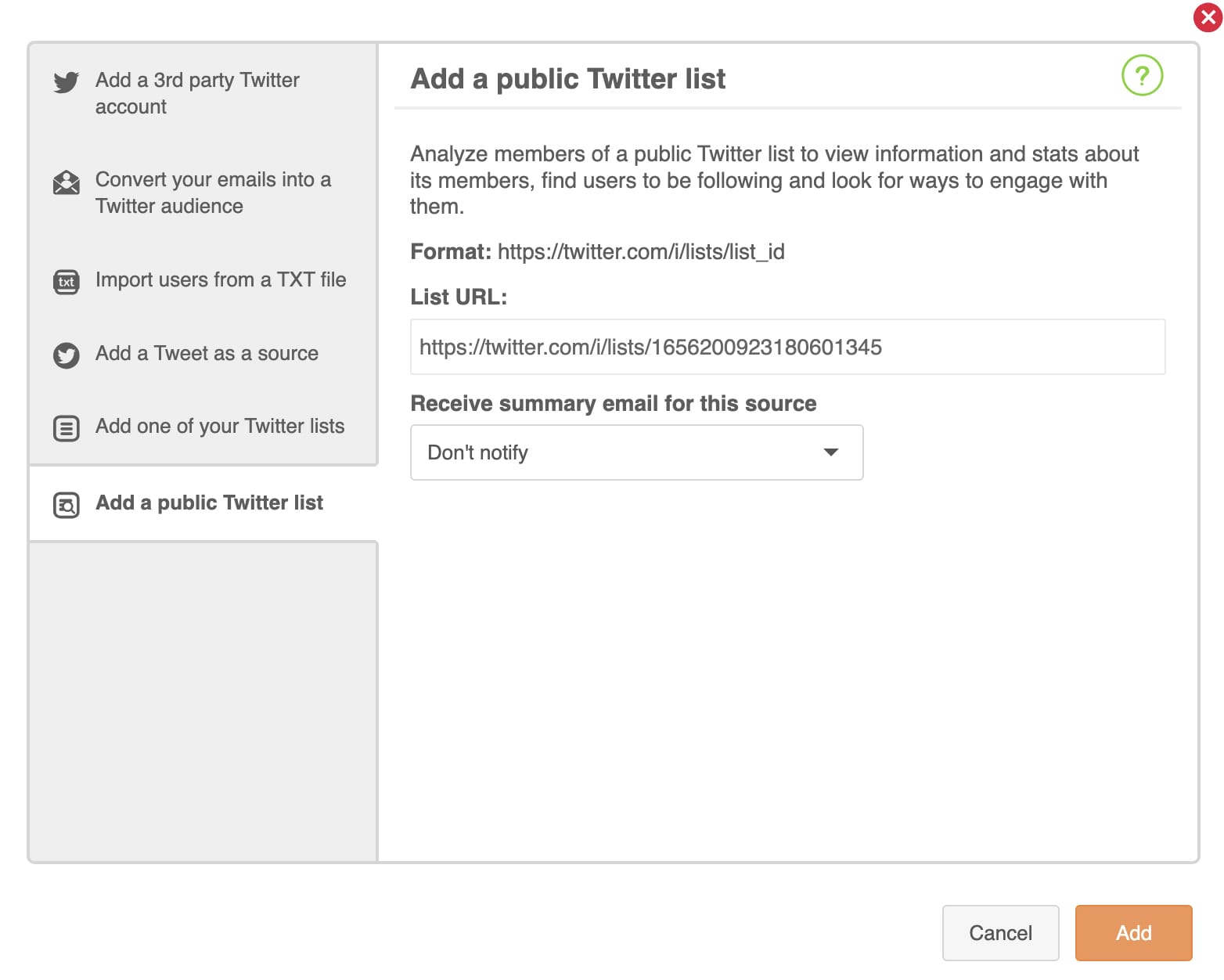
From your community wall, you can filter the list, follow the users, or apply custom tags.
Signup and use Audiense Connect for free.
Analyse retweeters
You can also find micro-influencers by searching some other accounts biggest fans.
But how to identify the fans?
One way is to find those who retweet particular tweets. Retweeting is a sign of affinity. With Tweet Binder it is possible to find retweeters with the following search operator:
Retweets_of:audienseco
Then you can use the Tweet Binder report to find top retweeters that might be influencers too. With a paid account, you can also download the report with the full list for further analysis.
Attend Twitter chats and spaces
One of the best ways to build relationships with influencers is to talk with them in real time. Use these tools to engage potential brand partners directly in the Twitter app:
- Twitter chats: Influencers and industry figures often hold these Q&A-style events. During a chat, you can answer the questions and engage with others’ responses. Then use Tweet Binder’s hashtag reports to analyze the event in real time or after the fact.
- Twitter spaces: While Twitter chats rely on tweets, spaces let you speak with industry figures. To get the most out of a space, listen to the hosts and ask to speak. If the space has a dedicated hashtag, add it to your tweets about the space. You can also use Tweet Binder reports to analyze Twitter space hashtags and speakers.
Host or attend industry events
Another way to find Twitter influencers is to connect in person. But attending or hosting industry events is only the first step.
Make a note of the event hashtag. Then follow it on Twitter to join the conversation and find relevant influencers.
Use Tweet Binder’s real-time reports to stay on top of meaningful conversations. That way you can monitor trends, find top contributors, and connect with influencers when it matters most.
Who is an influencer on Twitter by Tweet Binder
This question has been around for quite a long time here at Tweet Binder. What does it mean to be an influencer? How can I detect who is an influencer on a certain topic?
After giving it a long thought and after tons of months of study, we created a formula to detect influencers or people who can influence on certain topics or hashtags on Twitter.
For Tweet Binder, influencers are those people who meet one of these requirements:
- Influence a lot of people
- Influence a lot without mattering how many people
In both cases we consider that the account is influential.
Of course, an account that meets both requirements is a “super influencer”. Such as Katy Perry or Cristiano Ronaldo. But let’s not put our attention on those accounts. We are going to focus on those Twitter users who meet either of the aforementioned requirements.
Tweet Binder’s Twitter influence algorithm
First, we see how many people the user influences. We do this by calculating its value.
The number of followers is something important but it is not the only thing that we consider. The parameters that are taken into account are the same as the ones used to calculate the Twitter economic value of an account.
Second, we analyze the engagement of that account. This is done in order to see if the account has the engagement that is expected from it. Twitter’s engagement is calculated with the RTs and likes received to their tweets.
Let’s see an example: If Donald Trump sends a tweet and gets 100 RTs and 200 likes, can we say that it has been a successful tweet? Obviously not. For each tweet Donald Trump shares, thousands of RTs and likes are expected.
On the opposite side, if an account with 10 followers was to receive those 100 RTs and 200 Twitter likes, would it be a successful tweet? We’ll say yes. Why? Because a tweet from an account with 10 followers is expected to receive a smaller amount of RTs and likes.
At Tweet Binder we have analyzed and determined how much engagement (RTs and likes) is expected from an account given the followers it has. If the account has a higher engagement than expected, we will say that that account is very influential.
Type 1 of Twitter influencers: accounts that influence a lot of people
For our hashtag counter, accounts that influence a lot of people are considered as influencers. Maybe their engagement is not that high but they still influence a lot of users.
This group is formed by those accounts with a lot of followers. They don’t engage as much as expected but they impact a lot of users. Some of these accounts are media outlets or corporate companies such as Coca Cola.
Even though these accounts do not reach the levels of engagement they are supposed to, they still impact thousands of people; being, therefore, influential. It is important to note that the number of followers is not the only parameter that is taken into account. That is why we don’t have to focus just in the Twitter impressions and the tweetreach of a user.
Considering all the aforementioned, we have calculated the “influence percentile” for each account and it is shown as a percentage. This percentage goes from 0% to 100% and shows in which level the account is in relation to Twitter’s average. If, for example, an account shows a “influence percentile” of 65%, this means that it is more influential than the 65% of Twitter accounts. A percentage of 90% shows that an account influences a lot of users. Whereas accounts with lesser influence will be under 20-30%. An account with an “influence percentile” of 0 is an account that influences no one.
Type 2 of Twitter influencers: Accounts that influence a lot
We have already mentioned that the engagement of an account on Twitter is determined by the number of RTs and likes each tweet receives. At Tweet Binder we know how many RTs are expected from each account. For example, more RTs and likes are expected from an account of a public figure than from a regular citizen.
Once we know the expected engagement of an account, it is very easy to see if that account has got more, less or the same Twitter engagement as expected. That is the metric Tweet Binder uses to see if a Twitter user influences a lot or not. An account that gets 10 RTs when only 3 RTs are expected is an account that influences a lot because it influences more than predicted.
The fact that these accounts “influence a lot” doesn’t necessarily mean that they influence a lot of people. In fact, there will always be certain areas where users won’t impact a lot of people but their influence is huge. A pretty good example of this is an account that tweets about the migration of African turtles. This topic is not followed by thousands of users. However, accounts tweeting about it may have more engagement because their followers are likely to be fans of the African turtles and their migration. Therefore, they are more likely to retweet or like the tweets.
The key question here is: if we want to launch a campaign aimed for those who are passionate about the migration of African turtles, who should we contact? Those accounts who influence a lot but to a small amount of users? Or an account such as Taylor Swift who influences much more users? For us the answer is clear, the first option would be the best one. Plus, it will be cheaper.
This engagement is set at Tweet Binder with a new metric named “engagement score” that goes from A+ to F. An account with an F of “engagement score” is an account that gets less engagement than expected. It might get a lot of RTs and likes, but it does not get the numbers that are expected from that type of account. On the other hand, an account with an A+ of “engagement score” is an account with great engagement. Not because it gets a really high number of RTs and likes but because that number, whatever it is, is way higher than expected.
An account with 3 retweets can perfectly have an “engagement score” of A+.
How to find influencers on Twitter
After reading all of the above, it is clear that we have two types of Twitter influencers: those who influence a lot of users and those who influence a lot. Both are determined by the already explained metrics:
- Engagement score: from A+ to F
- Influence percentile: from 0% to 100%
Now, what is left to do is look for those accounts that could be interesting for our campaign or brand. Depending on the type of action, we’d rather use accounts with a high engagement score or accounts with a high influence percentile.
For the following example you can use this search box. It will allow you to create a free report of up to 500 tweets from the past 7 days.
Let’s see this with an example. We are going to try to find influencers who tweet about Fortnite (the video game) in Spanish. We aim to contact influencers for a fake Twitter campaign we intend to launch.

The first step will be to go to www.tweetbinder.com and type Fortnite in the search box (this will include the hashtag #Fortnite as well). Additionally, we want to filter by language Spanish and we will only look for those tweets that have got, at least, 2 retweets. We do this in order to take out bots and trash accounts. The query would be:
Fortnite lang:es min_retweets:2
This is going to give us the latest Spanish tweets about Fortnite with at least 2 retweets. We have set this limit of 2 retweets per tweet for it is a very popular game and those users who tweet about it and get 0 retweets are not influencers at all. The Twitter advanced search commands are really easy to use.
Given this example, we have 1,073 tweets from 612 accounts. Let’s see who is an influencer among those 612 users. After we hit the “influencers” button we will need to wait a few minutes until all users are uploaded.
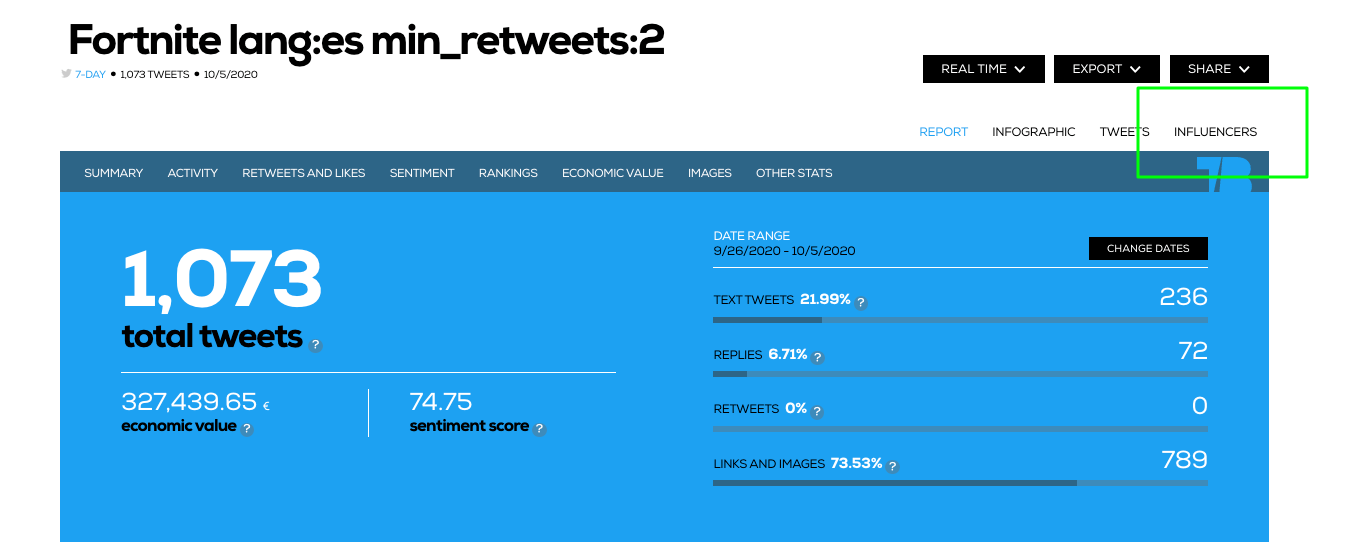
We are going to look for those accounts with a high “engagement score”. Let’s remember, these are going to be those accounts that are getting more engagement than expected. We can filter and arrange the information using the menu we find in the upper right corner of this section.
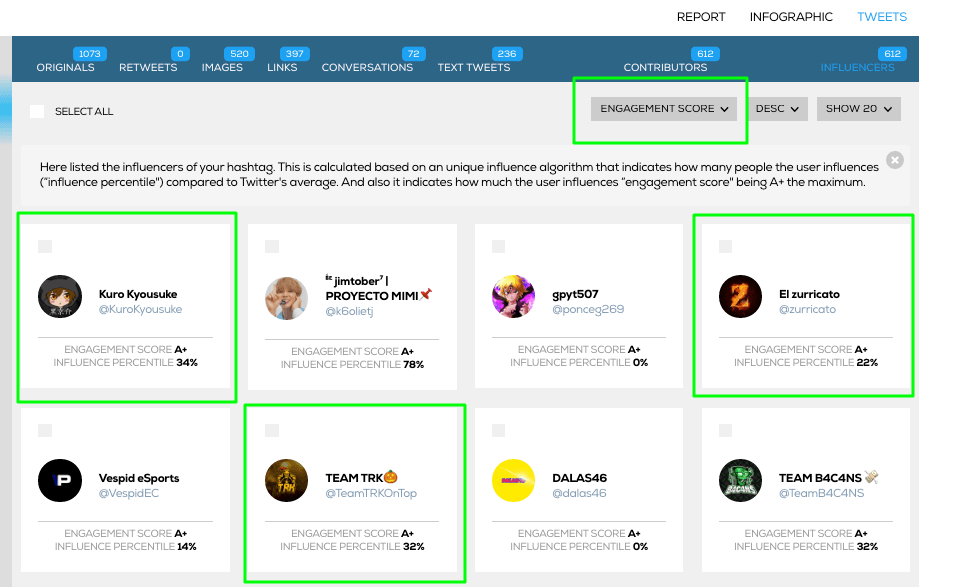
Once we have done this, we see some pretty interesting data coming up. There are some accounts that even though they have a low “influence percentile”, they have a high “engagement score”. Let’s look at these three examples:
- @KuroKyousuke: influence percentile: 34%, engagement score: A+
- @zurricato influence percentile: 22%, engagement score: A+
- @TeamTRKOnTop influence percentile: 32% engagement score: A+
Why are these accounts interesting? Because, even though they are accounts that do not influence a lot of people (their influence percentiles are low), their engagement is way higher than expected. Therefore, we will contact them with no hesitation. We could reach a good economic agreement with them and get good engagement rates.
Let’s see now who influences a lot of people, those with a high influence percentile. For this, we are going to arrange the users by their “influencer percentile”.
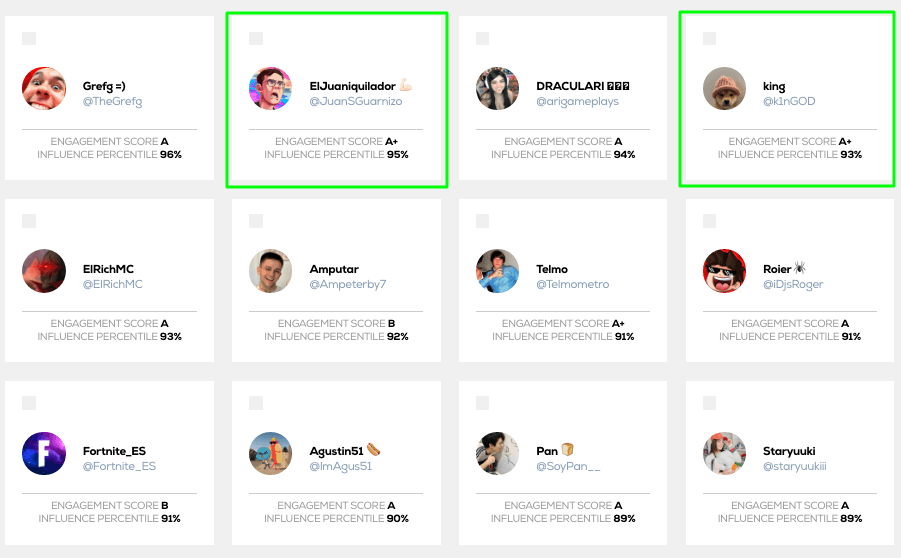
Immediately, the list of users looks completely different than before. We see accounts with more than a 89% “influence percentile” and with a “engagement score” of B or more, this is good. Any of these accounts can be considered as an “influencer” because not only do they influence a lot of people (high “influence percentile”) but they have a high “engagement score” as well. It is important to notice that having these types of influencers working for our campaign will be more expensive.
The best Twitter influencers from a Tweet Binder point of view would be:
- @JuanSGuarnizo: influence percentile: 95%, engagement score: A+
- @k1nGOD: influence percentile: 93%, engagement score: A+
Both accounts influence more than the 93% and 95% of the accounts on Twitter and they have more engagement than expected. And all of this considering that a really high engagement is expected from them.
Relation between the number of followers and being an influencer
To sum up, it is important to remark that the number of followers has little to do with being an influencer. To prove this point let’s have a look at the list of the users with a high amount of followers in our Fortnite example.
We can see accounts such as @CCNNEE (the CNN in Spanish), @ExpansionMX or @ElMundoEs. These three accounts together have more than 27 million followers. Well, none of these accounts have the highest influence nor engagement.
The number of followers is important to define the influence, but it is not the most important value. And it comes as less important when we are trying to figure out the engagement of the account.
5 Best influencer marketing platforms to find influencers on Twitter
While you can certainly use Twitter search to find influencers, the process is slow and clunky. Instead, use these tools to help find brand partners and create influencer marketing campaigns more efficiently.
1. Audiense Connect
Audiense Connect is a Twitter marketing tool designed for researching and managing your audience. With Audiense Connect, you can:
- Analyze all Twitter users, including your current followers
- Use your own custom settings to filter users and build an influencer list
- Add users to Twitter lists so you can engage and build relationships efficiently
Signup and use Audiense Connect for free.
2. Tweet Binder
Tweet Binder is a hashtag analytics tool that can find and monitor tweets on specific topics. With Tweet Binder, you can:
- Identify influencers based on the keywords and hashtags they tweet
- Find the most popular contributors to any conversation on Twitter
- Analyze conversations and influencers in real time
Use the search bar below to create a free report with up to 200 mentions from the last 7 days.
3. Upfluence
Upfluence is an influencer marketing platform that works across all major social networks. With Upfluence, you can:
- Search for Twitter influencers, including celebrities and micro influencers
- Filter influencers by engagement rate and number of followers
- Connect with Twitter influencers via email campaigns
4. GRIN
GRIN is a creator management platform for Twitter and other major social media networks. With GRIN, you can:
- Discover new influencers across social media channels
- Use social listening tools to help you find Twitter influencers
- Build and report on influencer marketing campaigns
Find influencers on Twitter
You need the right tactics and tools to find the right Twitter influencers.
Sign up for Audiense Connect so you can search users on Twitter, browse and segment them identifying Twitter influencers and building relationships today.
Tweet Binder gives you analytics of Twitter conversations and talkers behind it.

Javier is the founder and CEO at TweetBinder. With more than 10 years of experience in Twitter Analytics space, he is on the mission to build best-in-class Twitter marketing tools helping X community to thrive.
